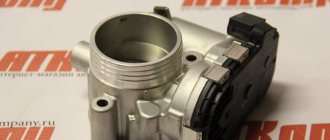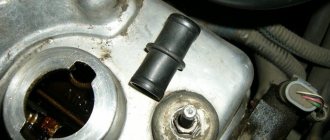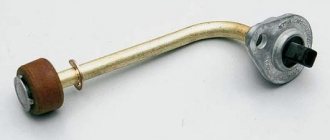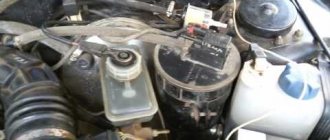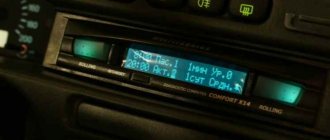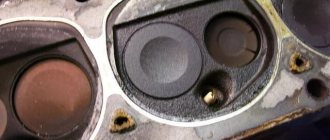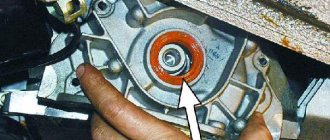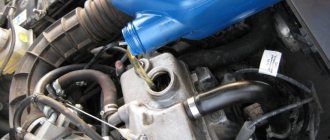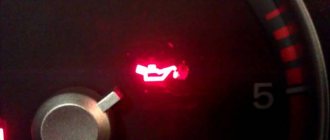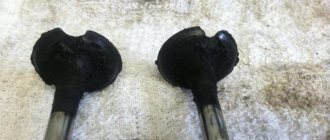Cars of the VAZ-2112 family were produced with one of two 16-valve engines - 21124 and 21120. The displacement of these engines is different, and only one part called the “cylinder head” is used - it is designated by the numbers 2112-1003011. There are rumors that the cylinder head from the 21120 engine does not fit the 24th engine, but a reverse replacement is possible. However, there is only one article in the spare parts catalog, and it is suitable for two motors at once. Next we consider what actions to repair the VAZ-2112 cylinder head you can perform yourself. We will only talk about 16-valve engines.
An example of dismantling is shown in the video. Let's see.
Passport details
Initially, the 12th was produced in 2 versions: 21120 and 21124. The characteristics of the 16-valve VAZ 2112 engine of these modifications are given in the following table.
| Engine model | 21120 | 21124 |
| Type | Gasoline 4-stroke | |
| Configuration | Inline 4-cylinder | |
| Nutrition method | Injection distributed injection | |
| Number of valves | 16 | |
| Working volume, l | 1,488 | 1,596 |
| Productivity, l. With. | 93 | 89 |
| Geometric dimensions Ø × L of the piston, mm | 82×71 | 82×75,6 |
| Compression | 10,5 | 10,3 |
| Maximum torsion moment Mkr, Nm | 140/3800 min -1 | 131/3700 min -1 |
| Toxicity standards | Euro-3 (on later engines - Euro-4) | |
It follows from the table that the technical characteristics of the two versions are quite similar, with the exception of the higher torque of the 120th engine.
Power core
The VAZ 2112 engine was not created from scratch. Its design with a 16-valve gas distribution mechanism (GRM) repeats the model 2110, and the cylinder block (BC) is a copy of the “eight” (21083). This can be verified by comparing their geometric parameters: bore diameter and center distances.
True, the blocks are not interchangeable, since they differ in the diameter of the cylinder head (cylinder head) mounting screws. Unlike parts 21083 and 2110, the BC has additional oil channels in the main bearings to supply oil to the lubricating nozzles. Through these devices, additional lubrication of the lower part of the cylinder surfaces is carried out, as well as cooling of the piston bottoms.
Now a little about how the 120th and 124th engines differ from each other. VAZ 21120 contains BC 2112 with a height of 194.8 mm, and 21124 contains BC 11193. The height parameter of the latter is 197.1 mm (the so-called “high” block). The 124th crankshaft has a longer stroke compared to the 12th. For motor 2112, the elbow has a size of 35.5 mm (stroke 71), and for motor 21124 it has a size of 37.8 mm (stroke 75.6). As a result, the working volume of the 124th version is 1.6 liters, versus 1.5 for the 120th.
The pistons also differ from each other. Both have counterbores to ensure the exit of the valve plate. However, on the 120 engine their depth is deceptive. It is designed only for the normal functioning of the timing belt, and in the event of a toothed belt break, the “meeting” of the valves with the pistons becomes inevitable. The 124th drive has everything in order; eliminating the incident will only require replacing the belt without disassembling the power unit.
Replacing the pistons on the 21120 engine with 124s will allow you to avoid the troubles associated with a broken belt. True, the power of the VAZ 2112 engine will be somewhat less.
Cleaning valve channels
To remove any valve, you will need to remove the camshaft. All screws on the bearing housing must be unscrewed evenly and tightened with a force of 10 N*m. The hydraulic compensator can be removed with a magnet, and then the valve is desiccated by compressing the spring with a puller (see photo).
How to remove the valve
There may be carbon deposits in the valve channels. It is cleared:
- Flat screwdriver;
- Sanding felt.
Grinding is carried out as follows: a rubber pipe is placed on the valve, a paste with diamond chips is applied (one drop), then the valve is pressed into the channel and scrolled. It will also be possible to change the valve stem seals (2112-1007026). You can’t do this without a special puller.
Cap puller
On any car, including the VAZ-2112, cylinder head repair comes down to cleaning and checking, as well as correcting geometry defects. In the latter case we are talking about milling. The presence of cracks and chips is a reason for replacement, not repair.
A small photo report
A burnt valve is immediately visible.
One valve burned out in cylinder 2
Carbon deposits were found in each valve channel.
Carbon layer in the cylinder head channels
Repair : cleaning all channels, replacing the valve with lapping. Direct repair of the VAZ 2112 cylinder head will require several operations that require some special equipment. Of course, this is not possible at home, and car enthusiasts simply replace worn parts. Next, we will consider the process of repairing the block head, as well as some of the nuances associated with this work.
Stages of block head repair
Before proceeding directly to the cylinder head repair process, it is worth noting that the head must be completely disassembled and all the necessary spare parts purchased. Let's consider the process of complete overhaul of the cylinder head.
Washing and crimping
The process of washing automobile spare parts with hot kerosene
In order to wash the head, it must be completely disassembled, that is, all parts that can be easily removed must be dismantled. For a complete wash you need 12 liters of hot kerosene. At car services, this is done using a sprayer that supplies liquid under pressure. This way, all the dirt and remaining metal shavings are washed away. The washing is carried out until the cylinder head is completely clean.
The process of crimping the cylinder head
Crimping is a process in which the integrity of a part is checked. Pressure testing can be carried out in two ways, which are basically similar. The first is to close all the cracks and fill the part with water. If there is water leaking or leaking somewhere, then the integrity has been compromised and repairs are necessary. The second method is to close all the cracks and immerse the head in an aqueous solution. It will be immediately obvious where the part is depressurized. If the integrity of the head is damaged, it must be restored.
Removing saddles
Before moving on to the rest of the overhaul steps, the valve seats must be removed. In the best case, they will easily be knocked out of their seat, and if not, then you will have to use Russian ingenuity.
The valve is welded to the seat and knocked out of the seat
So, what to do if the valve seats do not come out? The solution is simple. It is necessary to weld a tube to them so that the working end passes through the channel of the guide sleeve and knock it out until the seat comes off the mounting mount. Of course, cracks may form on the seat ring or a piece may break off. After completing the procedure, it is necessary to inspect the place and, if necessary, weld it with argon welding.
Check for deformation
Often, repairing a cylinder head is not complete without checking the plane. This can be done by contacting a car service that has a test stand, or asking your neighbor in the garage for a special ruler for measuring the cylinder head plane.
Measuring the cylinder head plane for deformation using a metal ruler and feeler gauge
Important! It is recommended to send such block heads to a car service with the appropriate equipment, since only there they will be able to measure the plane and grind it to the required size.
So, if there is deformation on the block head or the plane has a deflection, then it is necessary to grind it. This operation is performed on a special surface grinding machine. Typically, car experts recommend not removing more than 10 mm of thickness. Let's consider possible options for grinding the cylinder head by size:
- Repair 1 – 1-2.5 mm;
- Repair 2 – 2.5-5 mm;
- Repair 3 – 5-7.5 mm;
- Repair 4 - 10 mm - the maximum permissible value for grinding the GBU VAZ 2112.
Cylinder head surface grinding process
Note! If you remove a plane thickness of more than 10 mm, this can lead to incorrect operation of the timing mechanism, loss of power and increased fuel consumption.
Argon welding
Argon welding is welding work that is carried out on aluminum. For this purpose, a special gas is used - argon. Thus, in order to eliminate cracks and weld defects in valve seat seats, it is necessary to weld them, and then carry out milling work using special equipment.
The process of repairing cracks in the cylinder head using argon welding
Grinding
After the welding and milling work has been completed, it is necessary to bring the surface to readiness. To do this, the cylinder head is placed on a special stand, where the surface is polished using a special paste produced by ABRO or its analogues. This is necessary to ensure that the surface does not have roughness. When this procedure is completed, it is necessary to once again wash the part to remove metal shavings and remnants of the working material.
Other differences
The engines also differ in their “inhalation” design. The 120th intake consists of two aluminum parts: a manifold (“horn”) and a receiver, connected to each other by rubber corrugations. Unit 21124 is “decorated” by an intake system made of plastic and consisting of a single part.
The ignition system is designed differently. The VAZ 2112 is equipped with an ignition distributor module, and on the 21124, individual coils are installed for each cylinder. Due to differences in intake and ignition systems, valve covers also differ.
The 1.6-liter unit has some other differences from its brother: the pressure regulator has been moved from the fuel rail to the pump, the catalyst is located directly at the cylinder head, there are 2 oxygen sensors (Euro-3) instead of one (Euro-2) for the 1.5 liter. The split timing case design makes it easy to replace the timing belt.
People often ask: where is the serial number of the engine on the VAZ 2112? Indeed, the number located under the air filter is quite difficult to detect. It is located at the rear end of the BC, under the thermostat housing. To find the required numbers, you need to release the air filter mount and tilt it slightly to the side.
If corrosion makes it difficult to read the serial designation, you should use fine abrasive sandpaper and then wash the area with WD-40.
Possible faults
With proper care, the engine unit of the 12th family works flawlessly, because the basic design was created in collaboration with the German company Porsche, an authority in the field of engine building. The only “jamb” is the use of a belt drive. D
The problem is not even in her, but in the fact that the VAZ people stubbornly refuse to take into account Russian realities. The use of a timing belt requires high-quality spare parts, which, unfortunately, we can only dream of. And not everyone carries out regulated maintenance, relying on the well-known Russian “maybe”.
Repair and maintenance of the power unit
A specific case of repair work is given as an example. Repair of the VAZ 2112 engine was required for several reasons: you have to constantly add antifreeze, the lubrication indicator blinks, and the hydraulic compensators click. We preliminarily carried out a compression measurement, which showed a difference in the cylinders of up to two atmospheres.
During the disassembly process, the causes of the malfunction were identified:
- burnout of the cylinder head gasket, as a result of which antifreeze went into one of the cylinders;
- corrosion of the cylinder head mating plane;
- wear of the crankshaft main journal liners;
- wear of exhaust valve guides;
- sintering of the insides of the catalytic collector.
Description of engine restoration procedures:
- milling the head plane and the mating plane of the block;
- repressing exhaust valve guides;
- mechanical processing (without lapping) of valve seats;
Installation of new parts:
- pistons of size group C (instead of the original B);
- piston rings;
- crankshaft bearings and thrust half-rings;
- oil seals and gaskets;
- cooling pump;
- valve stem seals;
- metal cylinder head gasket from Priora;
- toothed belt complete with tension roller from Power Grip;
- INA hydraulic pushers;
- NGK spark plugs;
- “spider” 4-1 made of stainless steel;
People often ask: what kind of oil to pour into a VAZ 2112? In the described case, after assembly, Lukoil Lux 10W40 engine oil was filled in.
Changing the oil on a VAZ 2112 requires 3.3 liters of fluid, and with a concomitant filter change - 3.4, although the total volume of the lubrication system is 3.6 liters.
Installation
1. Wash the cylinder head from dirt and deposits with kerosene or diesel fuel.
2. Remove any remaining oil and coolant from the threaded holes of the cylinder block (under the cylinder head bolts).
3. We clean the mating surfaces of the head and cylinder block from the remains of the old gasket, and degrease the surfaces with a solvent.
Warning! Always use a new gasket when installing the cylinder head. Oil contact with the gasket surface is unacceptable.
4. Install the head guide bushings into the seats of the cylinder block. We place the gasket on the cylinder block, and the guide bushings should fit into the corresponding holes in the gasket.
5. Install the head on the cylinder block. By slightly moving the head from side to side, we ensure that the guide bushings fit into the corresponding recesses of the head.
Warning! Reuse of cylinder head bolts is only permitted if their length does not exceed 100 mm
6. Using a caliper or a bench ruler, measure the length of the bolts. Bolts longer than 100 mm are replaced.
7. Before installation, dip the threaded part of the bolts into engine oil and let the oil drain, waiting for about half an hour.
8. Install the head mounting bolts into the holes of the head. Using a torque wrench, tighten the head mounting bolts in three steps - first with a torque of 20 N m (2 kgf m), then turn the bolts by 90° and then turn the bolts again by 90°. In this case, we follow the order indicated in the photo.
Head bolt tightening sequence
Tuning options
Those who like to “grab” are interested in the question: how much additional horsepower can a tuning engine get? Tuning a 2112 engine is performed in different ways:
- Replacing the cam shafts with tuning ones (STI-1, STI-2, STI-3.1, Stolnikov 8.9) coupled with the installation of a lightweight ShPG, enlarged throttle valves and 4-2-1 “pants” will allow boosting the 120th engine to 120 hp. With;
- if you modify the cylinder head and install wide-phase camshafts, the increase will be 130 - 140 hp. With;
- installing a crankshaft with a long crank (37.8 mm), modifying the combustion chamber in the cylinder head and using T-shaped valves will increase the power to 150 hp. With.
Fans of “classic” Lada cars install the VAZ 2112 engine on rear-wheel drive cars: VAZ-2105, -2107. So that the unit can be located under the hood, even part of the engine compartment partition is cut out.
The generation of 12 engines turned out to be “long-lasting”. In addition to the brands described above, others were later developed: VAZ-21126, −127, −129. They are still installed today on LADA Priora, LADA Kalina, LADA Granta cars.
4.22. Cylinder head parts: 1 – cylinder head; 2 – intake camshaft; 3 – oil seal; 4 – exhaust camshaft; 5 – camshaft bearing housing; 6, 8 – sealing rings; 7 – guide pipe; 9 – block head cover; 10 – bracket for fastening the wiring harness; 11 – plugs; A – distinctive belt of the intake camshaft
Dismantling the cylinder head
First of all, to get to the cylinder head, you need to remove the cylinder head cover. For different 16-valve engines, this operation is different, and the cover part numbers also look different: 2112-1003260 (-10) and 21124-1003260.
Engine cover VAZ-21124 (1.6 l)
You will also need to remove the timing belt - there are no differences between different engines.
Let's look at how the exhaust manifold can be detached from the cylinder head. On engine 21120:
- Remove the exhaust pipe of the muffler: unscrew two nuts 1 (key “13”), remove the clamping bar, unscrew six nuts 2 (key “14”) and dismantle, not forgetting to turn off the oxygen sensor. The photo shows three of the six nuts.
Elements of the exhaust pipe
Everything important is under the screen
Now we will talk about engine 21124:
- Disable both oxygen sensors. We unscrew the three nuts securing the protective screen (with a 10mm wrench) and disassemble the bracket by unscrewing the four nuts with a 13mm wrench.
How to disassemble the mounting bracket
Operation with additional muffler
Here we believed that the VUT hose was disconnected from the intake module. Finally, the spark plugs are unscrewed on any of the engines (a “16” tubular wrench).
The tightening torques for the mounting screws are given in another text. In general, on VAZ-2112 hatchbacks, cylinder head repairs begin by replacing the “extended” screws with new ones. The length should be 95mm or less.
The order of unscrewing (left) and tightening the mounting screws
VAZ 2110 engine lubrication system:
1. Disconnect the wire from the negative terminal of the battery.
2. Drain the oil from the engine crankcase.
3. We also remove the camshaft drive belt.
4. Remove the oil sump from the engine.
5. On an engine with a fuel injection system, disconnect the block with wires from the crankshaft position sensor.
6. Using two screwdrivers, remove the pulley from the crankshaft.
7.If the key does not stay in the crankshaft groove, remove it so that it does not get lost.
8. Unscrew the bolts (there are 3 of them) that secure the oil receiver (remember that there are flat washers under the bolts) and remove the oil receiver.
10. Next, it is necessary to replace the sealing ring of the oil receiver, which has torn or lost its elasticity.
11. Unscrew the bolts (6 pieces) that secure the oil pump to the cylinder block, and remove the oil pump along with the gasket. Please note that there are flat washers under the bolts.
12. We rotate the oil pump drive gear in order to correctly install it on the crankshaft: the protrusions on the drive gear should coincide with the flats present on the crankshaft.
13. Before installing the pump, lubricate the working edge of the oil seal with engine oil. When installing the pump, carefully tuck the working edge of the oil seal onto the crankshaft journal using a wooden stick. Then fasten the pump mounting bolts. Then we install all the parts that were removed in reverse order. Check the tension of the camshaft drive belt.
If everything is done correctly, all defects in parts are identified and they are replaced, then the lubrication system of the VAZ 2110 should work without interruption. By the way, when removing the oil pump, it is advisable to replace the front crankshaft oil seal.
cylinder head VAZ 2112
The cylinder head is common to four cylinders; it is cast from an aluminum alloy, secured to the block with ten bolts and centered with two bushings. To ensure an even and tight fit of the head to the block, the bolts should be tightened on a cold engine in a certain sequence.
The head contains two camshafts, 16 valves with guide bushings and seats, and 16 hydraulic compensators.
The intake valve plate has a slightly larger diameter than the exhaust valve. This is done to better fill the cylinders with the working mixture.
The camshafts are five-bearing, cast, cast iron, each with eight cams. The intake and exhaust camshafts are not interchangeable. The camshaft supports are made in the head, and their covers are combined into a bearing housing mounted on the head. The bearing housing must be replaced as an assembly with the cylinder head. The bearing housing is closed on top by a cylinder head cover with an oil filler neck.
